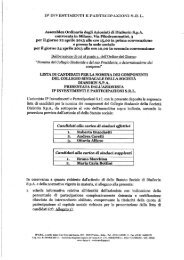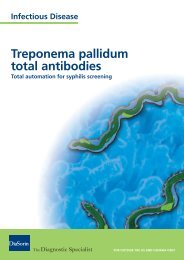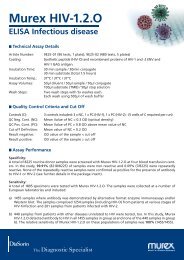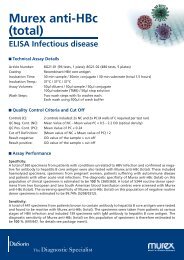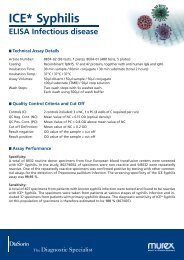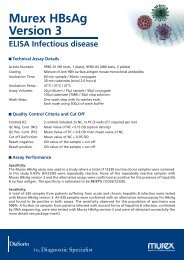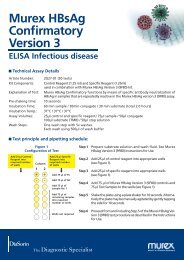Syphilis Booklet - DiaSorin
Syphilis Booklet - DiaSorin
Syphilis Booklet - DiaSorin
Create successful ePaper yourself
Turn your PDF publications into a flip-book with our unique Google optimized e-Paper software.
Table 10: Some common clinical situations producing false-positive results<br />
in syphilis tests<br />
VDRL and RPR<br />
Treponemal<br />
Transitory<br />
Hepatitis<br />
Mononucleosis caused by EBV<br />
Viral pneumonia<br />
Malaria<br />
Vaccinations<br />
Pregnancy<br />
Cardiovascular disease<br />
Technical error<br />
Permanent<br />
Connective diseases<br />
Immune system diseases<br />
Drug addiction<br />
Leprosy and tuberculosis<br />
Malignant diseases<br />
HIV infection<br />
Cardiovascular disease<br />
Multiple transfusions<br />
Permanent<br />
Endemic treponematosis<br />
Immune system diseases<br />
Lyme disease<br />
Leprosy<br />
Malignant disease<br />
HIV infection<br />
Cardiovascular disease<br />
Multiple transfusions<br />
in syphilis diagnosis over the past two years has<br />
been consolidating ELISA treponemal tests and<br />
chemiluminescence. These detect IgG and IgM<br />
antibodies either separately or simultaneously.<br />
The use of TpN15, 17, and 47 recombinant<br />
proteins has greatly improved performance (Cf.<br />
Fig. 2).<br />
2.2.2.2. ELISA for IgG detection<br />
This test was designed mostly for use with<br />
serum. Research has proven its high sensitivity<br />
and specificity, comparable both with TPHA<br />
and FTA-ABS, so ELISA IgG can be used instead<br />
of TPHA and FTA-ABS treponemal tests.<br />
Several trials have shown its outstanding rate<br />
of >92% sensitivity and >94% specificity,<br />
depending on the antigen used, both on<br />
treated and untreated patients. ELISA presents<br />
outstanding serum negative and serum<br />
positive selection capability, considering that<br />
serum negative patients rarely show indices<br />
>0.3, compared to >1.1 obtained with positive<br />
samples. 30–32 These tests enable automation and<br />
objective reading and the method features<br />
improved specificity.<br />
2.2.2.3. ELISA for IgM detection<br />
This is the diagnostic test of choice for early<br />
congenital and neonatal syphilis featuring 93<br />
to 99% sensitivity 30,31 and possible use with<br />
serum. Its capture method is the most sensitive<br />
test for detecting this type of immunoglobulin<br />
and is even better than FTA-ABS IgM. The test<br />
is a significant indicator in primary infection<br />
and symptomatic untreated stages. Even<br />
treatment monitoring has been successfully<br />
performed with this method. Its decrease in<br />
concentration becomes clear in 12 weeks and<br />
can be detected in persistent low titre<br />
infection. The disease cannot be classed as<br />
uncured or active only based on positive<br />
results. The main issue of this test is false<br />
negative results generation for infected prereactive<br />
children, which is why a negative<br />
result in a newborn child previously exposed<br />
to the disease cannot exclude possible<br />
congenital syphilis.<br />
2.2.2.4. Chemiluminescence<br />
This is the most recently developed technique<br />
and can be performed using either serum or<br />
Table 11: Treponemal Tests: limitations<br />
• More expensive<br />
• Cross-reactivity with other treponemes<br />
• False positive results<br />
• Unsuitable for monitoring treatment:<br />
85% of cured patients test positive<br />
15



